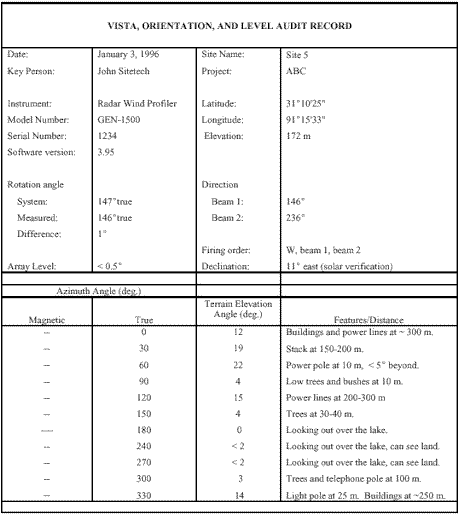9.6 Quality
Assurance and Quality Control
This
section provides information on QAQC procedures unique to upper-air
measurement systems. Generic material on QAQC procedures for meteorological
systems and definitions of terms used in QAQC is presented in Section 8.
With
some exceptions (e.g., rawinsonde measurements of pressure, temperature, and
humidity) upper-air monitoring systems provide indirect measurements of the
meteorological variables used in dispersion modeling. This presents a unique
challenge to the quality assurance and
quality control (QAQC) of these systems; for example, there is no upper-air
counterpart to the bench top calibration
of a wind vane. The alternative to the bench-top calibration is a calibration
using a collocated transfer standard; this involves locating an identical
instrument as close as practical to the
instrument being calibrated (see Section 8.3) - again, as with the bench-top procedure, there is no upper-air counterpart to
the collocated transfer standard for a wind vane.
Similarly, there is no upper-air counter part to the performance audit of a
wind vane (as explained in Section 8,
calibrations and audits are one and the same as far as "what"
takes place; the difference has to do
with the independence of the person conducting the audit). Given the inability to conduct a true performance audit,
the onus for claims of data validity for most upper-air measurements
falls on the systems audit - this, as explained in Section 8.4, is
essentially a challenge to the QAPP and
provides an overall assessment of the commitment to data validity.
Alternative
procedures for calibrations and performance audits of upper-air measurement
systems are based on inter-comparisons with other measurement systems -
these alternatives are discussed in
Sections 9.6.1 (Calibration Methods) and 9.6.2 (Systems and Performance
Audits).
Before
discussing quality assurance programs, it is useful to explain the
difference between quality control (QC) and quality assurance (QA). For the
purposes of this document, QC refers to
the operational procedures used to ensure that a measurement process is
working properly. QC procedures include
periodic instrument calibrations, site checks, data examination for
reasonableness, and data validation. QC procedures produce quantitative
documentation upon which claims of
accuracy can be based. QA refers to all the planned or systematic actions necessary to provide adequate confidence that
the entire measurement process is producing data that
meets the data quality objectives established for a monitoring program.
These actions include routine evaluation
of how the QC procedures are implemented (system audits) and assessments of
instrument performance (performance audits). Summarized below are details on the preparation of a Quality Assurance Project
Plan (QAPP) and key elements that are unique to upper-air
measurement methods.

9. UPPER-AIR MONITORING
9.1 Fundamentals
9.1.1 Upper-Air Meteorological Variables
9.1.2 Radiosonde Sounding System
9.1.3 Doppler Sodar
9.1.4 Radar Wind Profiler
9.1.5 RASS
9.2 Performance Characteristics
9.2.1 Definition of Performance Specifications
9.2.2 Performance Characteristics of Radiosonde Sounding Systems
9.2.3 Performance Characteristics of Remote Sensing Systems
9.3 Monitoring Objectives and Goals
9.3.1 Data Quality Objectives
9.4 Siting and Exposure
9.5 Installation and Acceptance Testing
9.6 Quality Assurance and Quality Control
9.6.1 Calibration Methods
9.6.2 System and Performance Audits
9.6.3 Standard Operating Procedures
9.6.4 Operational Checks and Preventive Maintenance
9.6.5 Corrective Action and Reporting
9.6.6 Common Problems Encountered in Upper-Air Data Collection
9.7 Data Processing and Management (DP&M)
9.7.1 Overview of Data Products
9.7.2 Steps in DP&M
9.7.3 Data Archiving
9.8 Recommendations for Upper-Air Data Collection
















